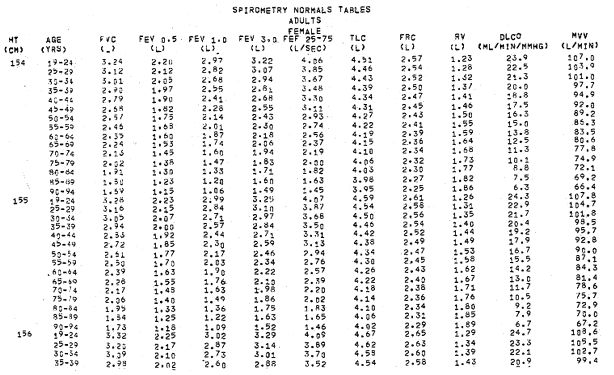A couple days ago I pulled my copy of the Intermountain Thoracic Society manual on pulmonary function testing off the bookshelf and thumbed through it a bit. It was first published in 1975 and was the first major attempt towards standardizing the performance and interpretation of PFTs.
My first thought was that we’ve come a long way since then. Most importantly our understanding of what spirometry can (and cannot) tell us has improved dramatically.
Equipment too, has advanced since 1975, most particularly due to the first equipment standards that were published in that decade. As a reminder, spirometer accuracy was not a given and there are number of studies dating from that time period that detailed just how woefully inaccurate many of them were.
In 1975 computerized spirometers were exceptionally rare and I was reminded of this because 141 pages (two-thirds!) of the ITS manual is filled with look-up tables for predicted values and ATPS – BTPS – STPD conversion factors.
Most spirometry systems were entirely manual and the majority of us measured FVC and FEV1 manually from pen tracings on kymograph paper. The results were then hand-calculated and then hand-written onto report forms. Since our equipment is so much more accurate and our computers acquire and calculate test results automatically, everything is so much better now, isn’t it?
Overall, I’d have to say yes. Testing is much quicker and more accurate than it used to be in 1975, and no, I’m not particularly nostalgic about those days.
{Arrrhh, gather round lads and lasses and let me tell you of the days when coal-fired steam-powered spirometers rumbled and hissed in basement labs everywhere; when you had to solve regression equations with your slide rule on the fly or risk the horror of ripped kymograph paper, exploding alveolar sample bags and spirometer bells gone ballistic without warning. The toll this daily physical and mental trauma took amongst the lowly pulmonary techs was terrifying and only the bravest continued the daily battle against gnarly patients, sneering doctors, black-hearted administrators and monopolistic manufacturers…
…Oops! Wrong time-line; those are memories from the universe one north and two left of ours. Too much steampunk sci-fi late at night and too little sleep left me momentarily confused…}
I ran across an error today that reminded me that although computerized test systems are essential to our ability to run efficient and accurate labs, at the same time the limitations of software that comes along with them hinders our ability to detect and correct errors.

